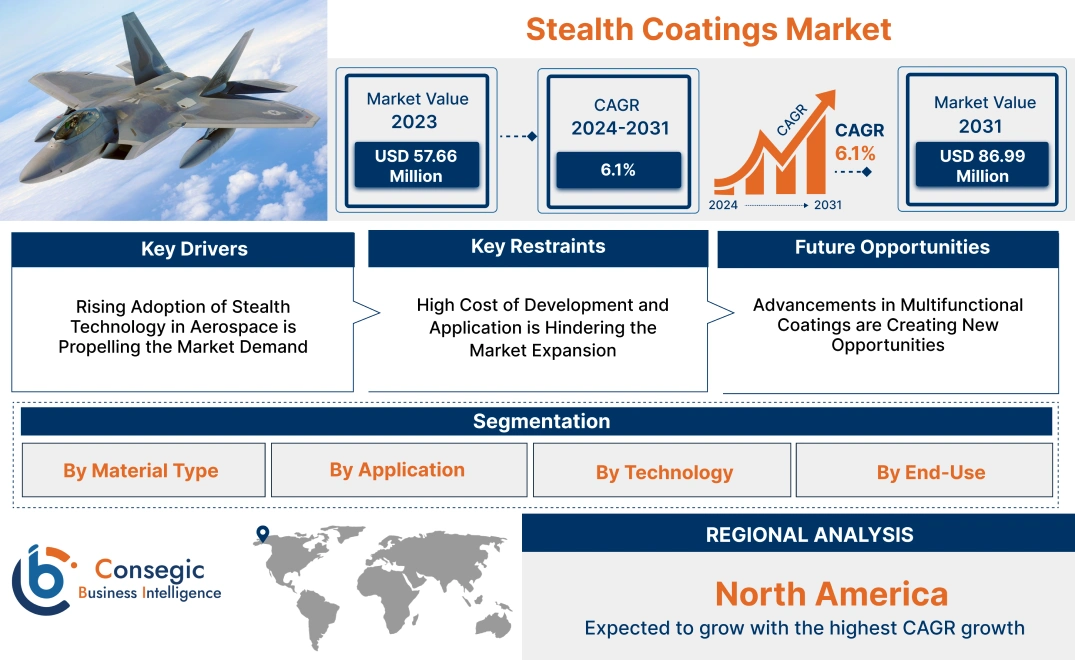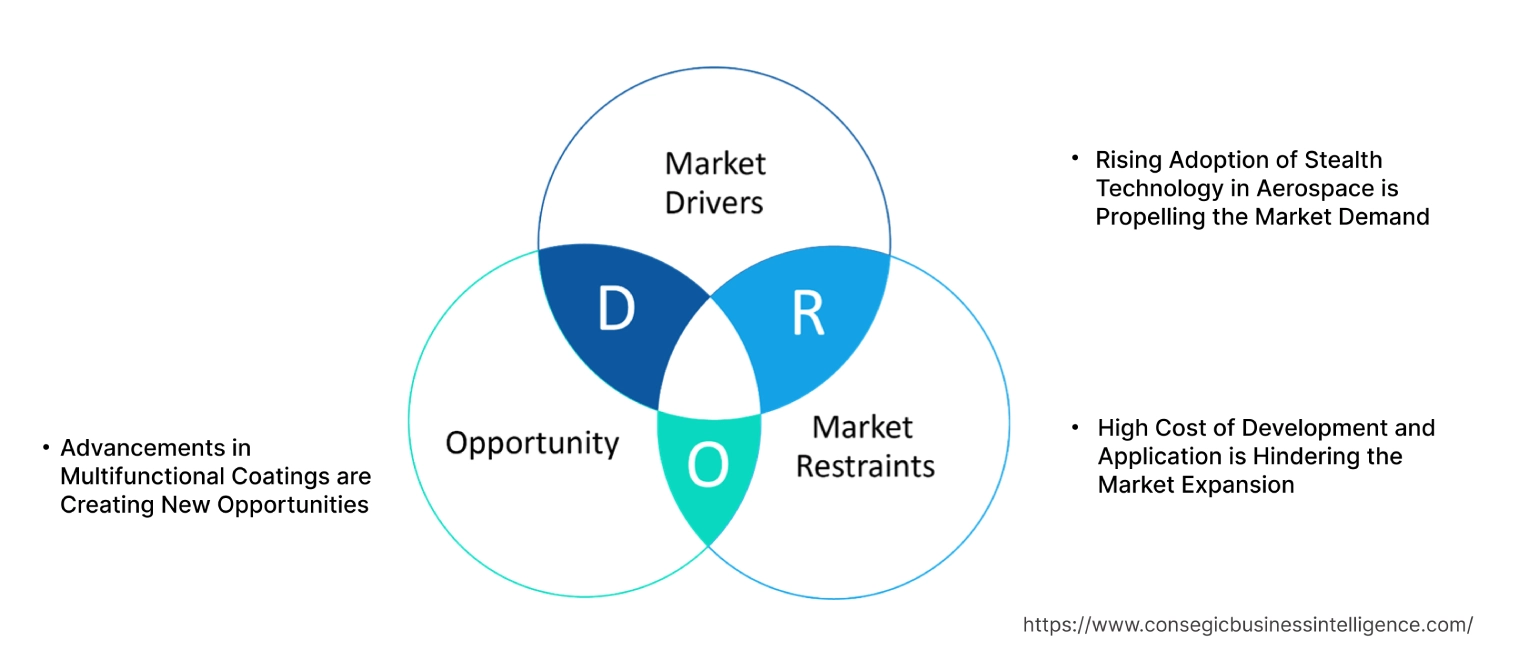Stealth Coatings Market Size:
Stealth Coatings Market size is estimated to reach over USD 86.99 Million by 2031 from a value of USD 57.66 Million in 2023, growing at a CAGR of 6.1% from 2024 to 2031.
Stealth Coatings Market Scope & Overview:
Stealth coatings refer to the industry centered around developing and supplying coatings that reduce the visibility or detectability of objects, particularly by radar, infrared, and any other detection systems. There are different types of stealth coatings such as radar-absorbing coatings, infrared stealth coatings, anti-reflective coatings, and thermal management coatings. Technological advancements in nanotechnology and material science have led to the development of more effective stealth coatings that are lighter, more durable, and more efficient at reducing detectability. End users of this market are entities and industries that benefit directly from the application such as defense and military, aerospace sector, automotive sector, and electronics and communication.
Stealth Coatings Market Dynamics - (DRO) :
Key Drivers:
Rising Adoption of Stealth Technology in Aerospace is Propelling the Market Demand
The rise in geopolitical conflicts and defense modernization initiatives across the globe has led to increased investment in stealth technology. Countries are looking to enhance the survivability and effectiveness of their military assets, including aircraft, naval ships, and ground vehicles. Stealth coatings that minimize infrared signatures are increasingly in demand, especially for military aircraft and drones, as infrared detection systems are becoming more advanced. Stealth technology is a crucial component of modern fighter jets, bombers, and unmanned aerial vehicles (UAVs). Countries are procuring advanced aircraft like the F-35 Lightning II and B-21 Raider, which rely on sophisticated stealth coatings and materials to avoid detection by enemy radar systems.
- In 2023, The Xianglong jet-powered UAS was on exhibit at the airshow, while the supersonic WZ-8 UAS and a revamped version of the GJ-11 stealth Unmanned Combat Air Vehicle (UCAV) were also revealed.
Therefore, as technological advancements continue and industries look for more effective ways to avoid detection and interference, the demand for stealth coatings, materials, and systems will continue to expand, boosting the stealth coatings market growth.
Key Restraints :
High Cost of Development and Application is Hindering the Market Expansion
Stealth coatings frequently use highly specialized materials such as radar-absorbent composites, carbon nanotubes, or metamaterials, which are costly to manufacture and produce. Stringent quality control methods are required to ensure the effectiveness of stealth coatings, which increases the overall cost. Due to the niche market for stealth technology, production volume is frequently low, resulting in higher per-unit costs. The expensive cost limits the widespread usage of stealth technology, particularly for non-military applications. For defense projects with restricted funds, adding stealth coatings leads to significant cost issues, also requiring trade-offs in other areas.
Therefore, the high cost of development and application presents a significant restraint on the stealth coatings market demand, affecting investments, material sourcing, application processes, and overall adoption rates.
Future Opportunities :
Advancements in Multifunctional Coatings are Creating New Opportunities
Multifunctional coatings represent a dynamic area of innovation within various industries offering the potential to combine multiple properties into a single solution. Coatings that incorporate sensor technology will be able to monitor the condition of the substrate, detecting corrosion, temperature changes, and structural integrity issues in real time. There is a growing adoption of sustainable and environmentally friendly coatings. Innovations in biodegradable materials and eco-friendly production processes will cater to this demand, minimizing the environmental impact of coating applications. In the future, there is an advancement for including coatings that will change color or finish based on temperature or electrical stimuli offering new customization options for consumers.
- In 2024, Machine learning is expected to play a major role in the advancement of technology in the modern world for stealth coatings. They are going to be very useful for establishing flying routes, controlling air paths, and responding instantly to threats.
Therefore, the future opportunities in multifunctional coatings are vast and varied, driven by advancements in material science and nanotechnology which will help in the stealth industry's future growth, promoting the stealth coatings market opportunities.
Stealth Coatings Market Segmental Analysis :
By Material Type:
Based on material type the market is segmented into Polyurethane, Epoxy, Acrylic, and Others.
Trends in the Material Type:
- Polyurethane coatings reduce the radar cross-section and thermal signatures of vehicles aircraft, ships, and other military equipment, making them hard to detect by enemy surveillance systems.
- Self-healing and nano-engineered epoxy coatings are emerging, offering the potential for coatings to automatically repair minor damages and extending their effectiveness, and lifespan.
The Polyurethane component accounted for the largest revenue share of 31.11% in the year 2023.
- Polyurethane provides excellent resistance to UV radiation, abrasion, chemicals, and extreme weather conditions which is crucial for military and aerospace assets that operate under varying climates and in combat zones.
- Polyurethane coatings offer exceptional protection against corrosion which is especially valuable for naval and aerospace applications. This protection helps to extend the life of vehicles exposed to moisture, saltwater, and other corrosive environments.
- The long lifespan of polyurethane coatings ensures cost-effectiveness, reducing the need for frequent maintenance or replacement, which is eventually driving revenue in the market.
- For instance, according to Science Direct, ATR-FTIR, and XPS analysis demonstrated that ultraviolet radiation was an important cause of the rupture of chemical bonds, the chain scission of the polyurethane was dominated by the C–N bond rupture.
- Thus, as per the market trends analysis, polyurethane's combination of durability, flexibility, stealth capabilities, and cost-effectiveness boosts the stealth coatings market growth.
The Epoxy component segment is anticipated to register the fastest CAGR during the forecast period.
- Epoxy coatings are known for their excellent adhesion which makes them particularly valuable in aerospace, automotive, and military applications, where strong adhesion is crucial for long-lasting stealth performance.
- They have excellent thermal resistance, which is essential for applications that require protection from extreme heat and temperature fluctuations.
- In industries like automotive and electronics, epoxy coatings protect against electromagnetic interference and thermal management, contributing to the growing market.
- For instance, Stealth Veils Epoxy Coatings have a very high heat deflection temperature and a greater shore durometer, making the finished surfaces much harder and more durable. This results in a significantly more scratch and impact-resistant coating than those now available on the market.
- Thus, its growing use in defense, aerospace, and other industrial applications, coupled with advancements in epoxy formulations makes it a key component for stealth coatings market expansion.
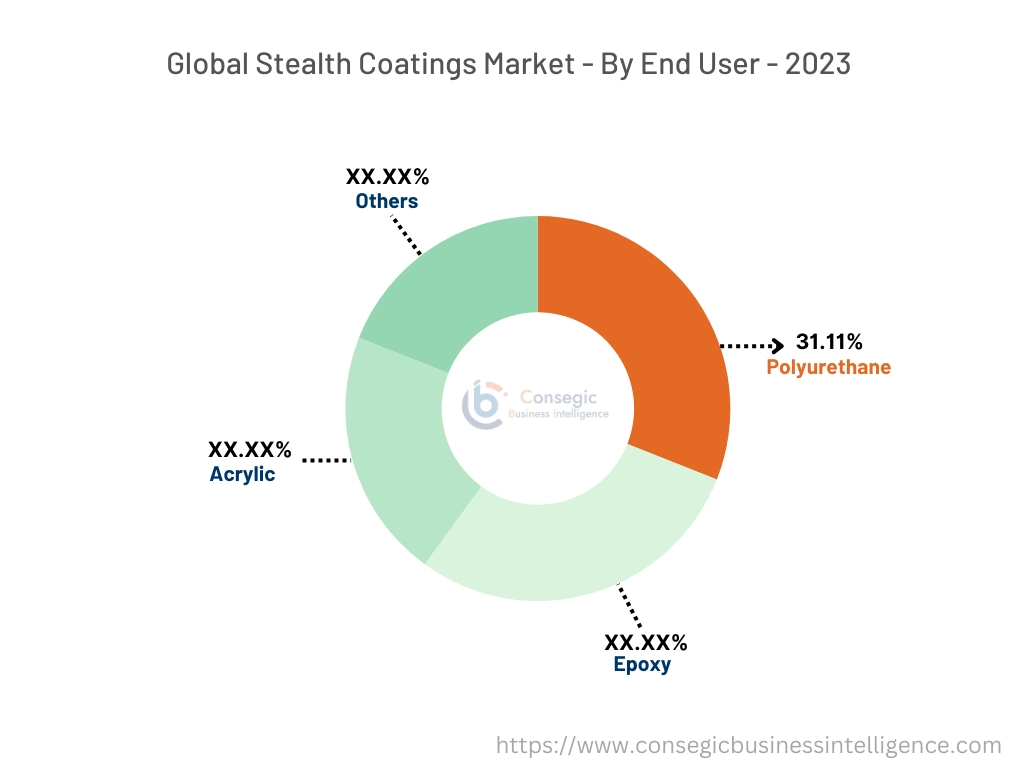
By Application:
Based on application the market is segmented into Aerospace & Defense, Marine, Automotive, Electronics, Energy, and Others.
Trends in the Application:
- In the commercial marine sector, stealth coatings are gaining traction for reducing the visibility of high-value cargo ships to pirates and other potential threats.
- In renewable energy sectors, particularly for offshore wind farms, stealth coatings are used to reduce radar cross-sections, helping to prevent interference with marine and aviation radar systems.
The Aerospace & Defense segment accounted for the largest revenue of the total stealth coatings market share in 2023.
- The aerospace and defense sectors prioritize stealth technology to reduce the visibility of aircraft, naval vessels, and ground vehicles to enemy radar and infrared detection systems. This need for low observability directly drives the demand for advanced stealth coatings.
- Navies around the world are modernizing their fleets with advanced stealth technology to counter threats posed by increasingly sophisticated anti-ship and anti-aircraft systems. Stealth coatings are essential for reducing the radar cross-section of naval vessels, and enhancing their survivability.
- Many military forces are retrofitting existing aircraft, ships, and ground vehicles with advanced stealth coatings to enhance their operational capabilities without the need for complete platform replacements.
- For instance, regarding aircraft, stealth technologies have altered the nature of aerial combat, allowing stealth fighters and bombers, such as the B2 stealth bomber, to engage the adversary with lower possibilities of being attacked.
- Thus, as nations prioritize advanced stealth technologies to ensure the effectiveness and survivability of their military assets, the aerospace and defense sector is expected to continue dominating the stealth coatings market trends in the coming years.
The Automotive segment is anticipated to register the fastest CAGR during the forecast period.
- The automotive sector's shift towards electric vehicles is accelerating the adoption of advanced coatings, including stealth coatings. These coatings can improve thermal management, which is essential for EV battery efficiency and overall vehicle performance.
- The automotive sector is increasingly focused on enhancing vehicle security, especially with the rise in vehicle theft and vandalism. Stealth coatings can help protect sensitive components from environmental factors and reduce the visibility of security features.
- The automotive sector is moving towards lightweight materials to improve fuel efficiency and performance. Stealth coatings can be applied to these materials, protecting them without adding significant weight.
- Thus, the automotive component segment is anticipated to register due to rising adoption of electric vehicles, focus on aerodynamics, integration of advanced technologies, and consumer preferences for customization, propelling the stealth coatings market expansion.
By Technology:
Based on technology the market is segmented into Radar-Absorbing Coatings, Infrared-Absorbing Coatings, Thermal-Absorbing Coatings, and Anti-Reflection Coatings.
Trends in the Technology:
- The development and procurement of next-generation stealth fighter jets and unmanned aerial vehicles contributed to the dominance of radar-absorbing coatings in stealth technology applications.
The Radar-Absorbing Coatings segment accounted for the largest revenue of the total stealth coatings market share in 2023.
- Radar-absorbing coatings play a pivotal role in military applications by reducing radar detectability which is essential for enhancing the stealth capabilities of aircraft, naval vessels, and drones. They help to protect military assets from enemy radar.
- Naval ships, submarines, and drones utilize radar-absorbing coatings to evade detection by enemy radar. The growing use of stealth technology in the maritime domain has been a significant factor in increasing the market.
- The growing importance of radar evasion in modern warfare, along with increasing investment in stealth technology, significantly boosted the adoption of radar-absorbing coatings.
- For instance, DRDO Defense Laboratory has effectively created radar-absorbing paint which will be used on a variety of platforms and even on its fighter aircrafts.
- Thus, the radar-absorbing coatings segment is poised for the largest segment due to its critical role in reducing radar detection for military and aerospace applications along with technological advancements, driving the stealth coatings market demand.
The Infrared-Absorbing Coatings segment is anticipated to register the fastest CAGR during the forecast period.
- The aerospace sector has been a major adopter of infrared absorbing coatings, particularly for military aircraft and unmanned aerial vehicles (UAVs). These coatings help aircraft evade detection by infrared-based tracking systems used by adversaries.
- The adoption of infrared-absorbing coatings is rising in commercial aviation, telecommunications equipment, and consumer electronics, where thermal regulation and reducing interference are crucial for performance and longevity.
- These coatings are a key component in multi-spectral stealth technology, which aims to reduce an object's visibility across multiple detection spectrums, including radar, infrared, and optical wavelengths.
- For instance, according to European Coatings, the infrared stealth effect is influenced by both temperature and infrared emissivity, although most previous research has focused on a single factor, limiting product performance. Researchers now have created double-shell microcapsules (DSMs) with temperature control and low infrared emissivity.
- Thus, the segmental analysis shows that advancements in infrared absorption materials, the expansion of drone and UAV usage, and the adoption of multi-spectral stealth technology across various industries are driving stealth coatings market trends.
By End-Use:
Based on end-use the market is segmented into Military & Defense, Commercial, and Industrial.
Trends in the End-User:
- Stealth coatings help protect sensitive 5G equipment from signal interference thus ensuring reliable and fast communication. Coatings that provide electromagnetic interference shielding are becoming essential for telecommunication equipment like towers, antennas, and base stations.
The Military & Defense segment accounted for the largest revenue share in the year 2023.
- The military sector is increasingly focused on developing advanced stealth technology to minimize the radar cross-section and infrared signatures of their assets.
- The need for stealth capabilities in naval warfare, particularly in scenarios involving anti-access or area denial strategies, has propelled growth in this segment.
- Ground vehicles such as tanks and armored personnel carriers are increasingly utilizing stealth coatings to avoid detection by enemy forces. The need for stealth in ground operations, especially in urban environments, contributes to the revenue generation by this segment.
- For instance, as per Defense Industries the merchant navy was once linked with the transfer of commodities and cargo at sea via ships, but it is now involved in the development of stealth features to protect valuable cargo consignments and threats when moving through difficult zones.
- Regarding aircraft, stealth technologies have altered the nature of aerial combat, allowing stealth fighters and bombers, such as the B2 stealth bomber, to engage the adversary with lower possibilities of being attacked.
- Thus, the segmental trends analysis shows that the military and defense component dominated the stealth coatings due to the heightened defense technology, advanced stealth technology, and modernization initiatives across military branches.
The Industrial segment is anticipated to register the fastest CAGR during the forecast period.
- Industries are increasingly using infrared absorbing and electromagnetic interference shielding coatings in their operations. These coatings help protect sensitive equipment from heat and electronic detection, essential in sectors like electronics, aerospace, and telecommunications.
- The adoption of stealth technology in commercial aviation and electric vehicles is becoming more prevalent, further contributing to the growth of the industrial segment.
- As the oil and gas sector focuses on improving operational efficiency and extending the lifespan of equipment, the adoption of advanced coatings is propelling the market revenue.
- For instance, according to UQG Optics, the telecommunications sector extensively relies on optical coatings for fiber-optic communication systems. In fiber-optic networks, coatings play an important role in decreasing signal losses and increasing data transmission efficiency.
- Thus, analysis shows that the stealth coatings market is poised for rapid growth due to the rising adoption of advanced coatings in various industries.
Regional Analysis:
The regions covered are North America, Europe, Asia Pacific, the Middle East and Africa, and Latin America.
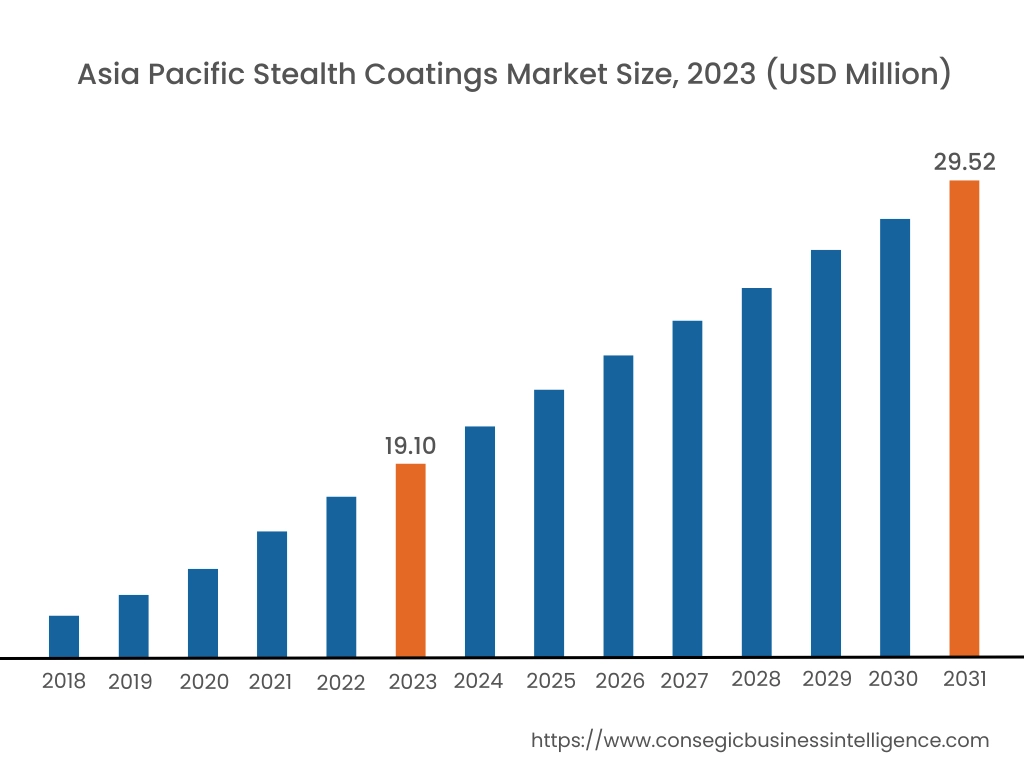
In 2023, Asia Pacific accounted for the highest market share at 33.12% and was valued at USD 19.10 Million, and is expected to reach USD 29.52 Million in 2031. In Asia Pacific, China accounted for the highest market share of 21.25% during the base year of 2023. As per the stealth coatings market analysis, the Asia Pacific region is making significant investments in renewable energy infrastructure, particularly in wind and solar power. Offshore wind farms in China, Japan, and South Korea are driving the adoption of stealth coatings that protect critical infrastructures from environmental damage and reduce radar cross-section.
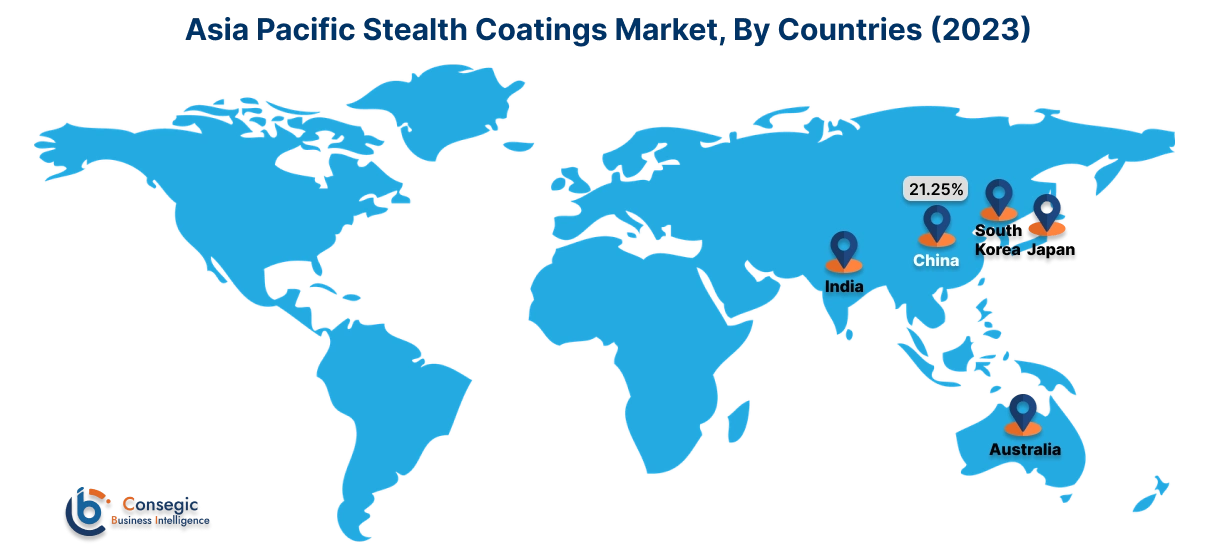
North America is expected to witness the fastest CAGR over the forecast period of 6.8% during 2024-2031. In North America, the stealth coatings market has witnessed substantial growth, driven by advancements in the aerospace, defense, automotive, and electronics industries. The ongoing development of advanced stealth aircraft like the F-35 along with the modernization programs has led to a significant adoption of radar-absorbing and infrared-suppressing stealth coatings.
- In 2022, Hyper Stealth Technologies Pvt Ltdrevealed a breakthrough in stealth coating technology, revealing a unique application procedure that dramatically improves endurance and efficacy, transforming stealth capabilities for military platforms around the world.
Europe leads in the development and procurement of next-generation military aircraft such as the Eurofighter Typhoon and the F-35 Lightning ll, driving the need for advanced stealth coatings for absorbing radar waves and minimizing thermal signatures.
The Middle East and Africa are major producers of oil and gas, with growing investments in critical infrastructure such as power plants, refineries, and renewable energy projects. Stealth coatings are being used to protect these critical assets from electromagnetic interference and other possible threats.
In Latin America, the countries are increasing their defense budgets in response to regional security concerns, political instability, and the need to modernize military capabilities. Countries such as Brazil, Mexico, and Colombia are investing in advanced military technology, which includes stealth coatings.
Top Key Players & Market Share Insights:
The stealth coatings market is highly competitive with major players providing products and services to the national and international markets. Key players are adopting several strategies in research and development (R&D), product innovation, and end-user launches to hold a strong position in the global stealth coatings market. Key players in the stealth coatings industry include-
- Intermat Defense (France)
- Hyper Stealth Technologies Pvt. Ltd. (Canada)
- AkzoNobel N.V. (Netherlands)
- Raytheon Technologies Corporation (USA)
- Lockheed Martin Corporation (USA)
- Stealth Veils (USA)
- Northrop Grumman Corporation (USA)
- CFI Solutions (USA)
- PPG Industries, Inc. (USA)
- MTL Advanced Ltd. (UK)
Recent Industry Developments :
Product Launch:
- In late May 2023, Boeing Defense, Space & Security's Phantom Works division announced the construction of a new Advanced Coating Center in St. Louis, set to be operational in 2025. This coincided with the public debut of the MQ-28 Ghost Bat in the U.S. at Mid-America St. Louis Airport, alongside the MQ-25 Stingray Refueller.
Stealth Coatings Market Report Insights :
| Report Attributes | Report Details |
| Study Timeline | 2018-2031 |
| Market Size in 2031 | USD 86.99 Million |
| CAGR (2024-2031) | 6.1% |
| By Material Type |
|
| By Application |
|
| By Technology |
|
| By End-Use |
|
| By Region |
|
| Key Players |
|
| North America | U.S. Canada Mexico |
| Europe | U.K. Germany France Spain Italy Russia Benelux Rest of Europe |
| APAC | China South Korea Japan India Australia ASEAN Rest of Asia-Pacific |
| Middle East and Africa | GCC Turkey South Africa Rest of MEA |
| LATAM | Brazil Argentina Chile Rest of LATAM |
| Report Coverage |
|
Key Questions Answered in the Report
How big is the Stealth Coatings Market? +
Stealth Coatings Market size is estimated to reach over USD 86.99 Million by 2031 from a value of USD 57.66 Million in 2023, growing at a CAGR of 6.1% from 2024 to 2031.
Which is the fastest-growing region in the stealth coatings market? +
North America is the fastest-growing region in the stealth coatings market.
What specific segmentation details are covered in the stealth coatings market report? +
The specific segments that are covered in the stealth coatings market report are material type, application, technology, and end-user.
Who are the major players in the stealth coatings market? +
The major players in the stealth coatings market are Intermat Defense (France), Hyper Stealth Technologies Pvt. Ltd. (Canada), Stealth Veils (USA), Northrop Grumman Corporation (USA), Raytheon Technologies Corporation (USA), Lockheed Martin Corporation (USA), CFI Solutions (USA), PPG Industries, Inc. (USA), MTL Advanced Ltd. (UK), and AkzoNobel N.V. (Netherlands).
